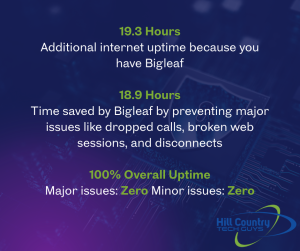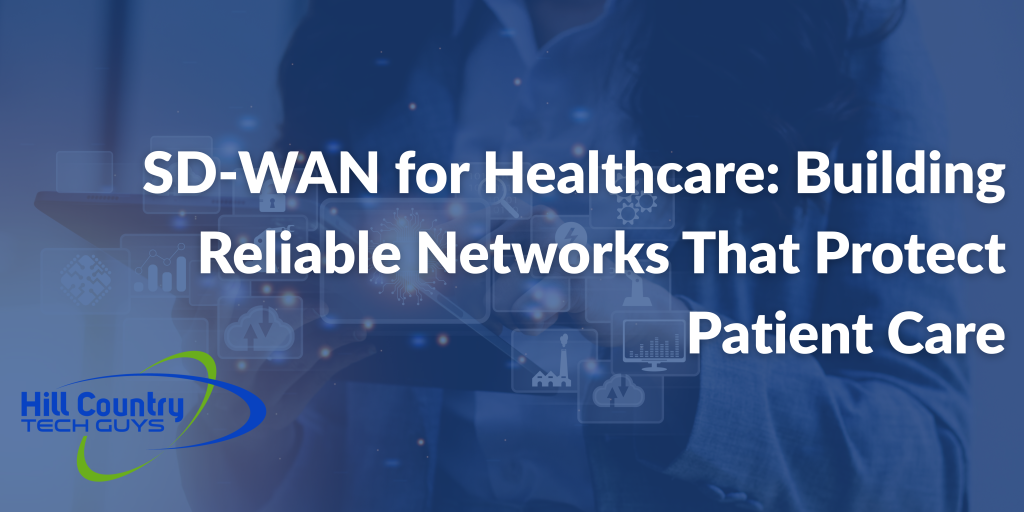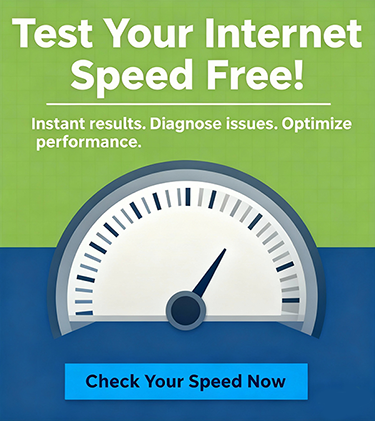Why Healthcare Needs Reliable Network Uptime
In healthcare, downtime is more than an inconvenience. It’s a risk. Losing access to electronic health records (EHRs), telehealth platforms, or imaging systems can delay treatment and impact patient safety. That’s why healthcare IT leaders are prioritizing network uptime as a core strategy.
For many healthcare organizations, the answer is SD-WAN. When combined with network redundancy and failover strategies, SD-WAN creates a smarter, more resilient infrastructure that keeps care moving even when the unexpected happens.
What Is SD-WAN?
At its core, SD-WAN is a smarter way to run your internet. It uses software to spread traffic across multiple connections, so if one has problems, your network automatically switches to the best option to keep everything running.
More technically, SD-WAN (Software-Defined Wide Area Networking) is a technology that uses software to manage and control how data travels across your network. Instead of relying on a single internet connection or a fixed hardware setup, SD-WAN allows you to use multiple connections (like fiber, broadband, and LTE) and route traffic intelligently across them.
Key points about SD-WAN:
It continuously monitors the health of all available connections.
It automatically chooses the best path for traffic in real time.
It gives IT teams visibility and control over network performance.
For hospitals and clinics, SD-WAN means you are no longer at the mercy of one unstable internet line. The system adapts instantly, keeping patient care applications running smoothly even if one connection has problems.
What Is Failover and Why Does It Matter in Healthcare
Failover works like a backup plan for your network. When the primary connection or device stops working, failover automatically switches to another one so everything keeps running.
In healthcare, that looks like:
The network reroutes traffic to a backup line the moment the main internet goes down.
A standby firewall takes over instantly if the primary one fails.
Hospitals and clinics rely on failover to give doctors, nurses, and staff uninterrupted access to the systems they need for patient care. No more delay in critical meds from the pharmacy or gaps patient information.
Network Redundancy in Healthcare IT
Redundancy makes failover possible. It gives your network more than one path to keep running when something breaks.
In healthcare IT, redundancy includes:
Running two internet service providers instead of one.
Keeping backup routers and firewalls ready to activate.
Using cloud storage so patient data stays safe if local servers fail.
When IT teams build redundancy and failover together, they turn fragile networks into reliable ones. That reliability protects patient care and helps organizations meet compliance requirements.
How SD-WAN Improves Healthcare IT Uptime
Traditional failover only activates when a connection goes completely offline. That still leaves room for issues like dropped calls, frozen telehealth sessions, or slow access to EHRs.
SD-WAN solutions in healthcare take it a step further. It constantly monitors the quality of network connections by tracking latency, jitter, and packet loss. It then automatically routes traffic along the best-performing path in real time.
For hospitals and clinics, this means:
Telehealth visits run without interruptions.
Imaging files transfer quickly and reliably.
Providers across departments have seamless access to records and applications.
SD-WAN is not just reactive. It is proactive, ensuring consistent healthcare IT uptime.
Case Study: A Rural Hospital’s Uptime Transformation
Before implementing SD-WAN, one rural hospital dealt with daily internet problems that directly impacted patient care. Staff struggled to reliably access electronic health records, telehealth appointments often dropped mid-call, and even small outages created risks that slowed down treatment and frustrated patients. Leadership knew they needed to act quickly so they reached out to Hill Country Tech Guys for help.
 After deploying SD-WAN with built-in failover and redundancy, tailored for healthcare, the hospital’s experience changed completely. For the past seven years, the hospital has not experienced a single outage that disrupted patient care. Providers trust their systems to work consistently, even when one internet line slows or fails. What was once fragile and unpredictable became reliable and resilient.
After deploying SD-WAN with built-in failover and redundancy, tailored for healthcare, the hospital’s experience changed completely. For the past seven years, the hospital has not experienced a single outage that disrupted patient care. Providers trust their systems to work consistently, even when one internet line slows or fails. What was once fragile and unpredictable became reliable and resilient.
The results speak for themselves:
In August 2025, the hospital gained 19.3 additional hours of uptime.
SD-WAN prevented 18.9 hours of major disruptions such as dropped calls and broken web sessions.
The facility achieved 100% uptime for the month.
With SD-WAN, the hospital can also make changes to its internet service, like switching providers or upgrading connections, without any impact on daily operations. This flexibility gives IT staff more control and allows leadership to focus on improving patient services instead of worrying about downtime.
Why Network Uptime Is Different in Healthcare
Most businesses see downtime as lost productivity. In healthcare, downtime can mean:
Missed patient records.
Delayed diagnoses.
Interrupted telehealth sessions.
Medication or scheduling errors.
That is why network redundancy in healthcare is not optional. It is a patient safety issue. IT leaders must design systems where uptime is nearly guaranteed, not just expected.
The Human Cost of Network Downtime in Healthcare
When healthcare networks go down, the impact reaches far beyond IT. Downtime directly affects how providers deliver care and how patients experience it.
Delayed treatments: If electronic health records (EHRs) are unavailable, clinicians may not have access to patient histories, lab results, or imaging when they need them.
Medication risks: Interruptions in pharmacy systems can delay prescriptions or cause dangerous errors.
Interrupted communication: Telehealth appointments and secure messaging can drop mid-session, leaving patients frustrated and providers unable to connect.
Patient safety concerns: Even short outages can lead to gaps in monitoring, scheduling errors, or missed updates in patient charts.
Research published in the Journal of the American Medical Informatics Association found that hospitals experience an average of 43 hours of EHR downtime per year, underscoring just how common and disruptive these events can be.
Downtime doesn’t just cost money. It costs time, trust, and in some cases, patient safety. That’s why healthcare organizations are turning to SD-WAN, redundancy, and failover strategies to ensure their systems remain available when they are needed most.
What is SD-WAN for Healthcare?
How does SD-WAN improve healthcare IT uptime?
Is SD-WAN required for healthcare compliance?
What's the difference between SD-WAN and traditional failover?
Steps to Improve Healthcare Network Uptime
If your organization is considering SD-WAN, here are key steps to build a stronger and more resilient network:
- Identify single points of failure. Review your current setup and find where a single outage could take down your operations.
- Add redundancy. Bring in backup internet connections, hardware, or cloud-based services.
- Test failover regularly. Run simulations so you know backups will activate when needed.
- Prioritize critical traffic. Ensure EHR systems and telehealth always have top priority.
- Monitor continuously. Use tools that give your IT team constant visibility into network health.
At Hill Country Tech Guys, we help hospitals and clinics turn this checklist into a working strategy. From design to implementation, we make sure redundancy, failover, and SD-WAN keep your systems reliable and your patient care uninterrupted.
SD-WAN for Healthcare Is About More Than IT
Network resilience comes down to two things: redundancy and failover. With SD-WAN, healthcare organizations get smarter failover strategies that deliver consistent uptime and protect patient care.
If your hospital or clinic is relying on a single internet provider or an untested backup plan, it is time to revisit your strategy. Because in healthcare, downtime is not just an inconvenience. It is a risk.
📞 830-386-4234
✉️ help@hctechguys.com
🌐 hctechguys.com




